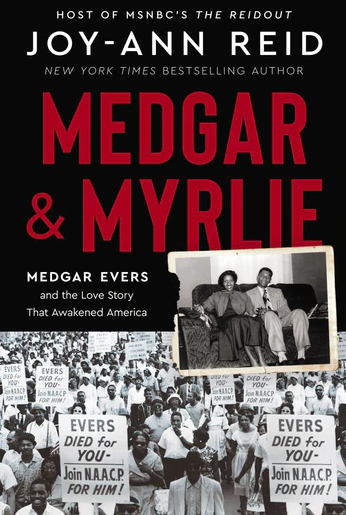Medgar & Myrlie: Medgar Evers and the Love Story that Awakened America
- By Joy-Ann Reid
- Mariner Books
- 352 pp.
- Reviewed by Paul D. Pearlstein
- February 28, 2024
An appealing look at the civil-rights icons’ private lives.

At the very beginning of Medgar & Myrlie, MSNBC host Joy-Ann Reid’s chronicle of assassinated civil-rights champion Medgar Wiley Evers and his wife, Myrlie Louise Beasley Evers, the author states, “This book is first and foremost, a love story.” I disagree.
The narrative tracks a compulsive Medgar as he tries to combat racism in Mississippi, working around the clock while his young wife struggles to raise their three children mostly by herself. Apparently, Myrlie got in the way of Medgar’s mission. On one occasion, an aggravated Medgar drives her home to her family in Vicksburg, telling the Beasleys, “I’m bringing your child back to you.”
Such conduct does not evoke marital bliss. Much of the love in this book, instead, surrounds Myrlie’s endurance and devotion to her husband’s vision. Their mutual love emerges more clearly after Medgar is assassinated.
This reviewer found two books in one. The first introduces us to Medgar, his family, his experience as a Black soldier in Europe during World War II, and his commitment to fighting racism when he returned home. He enrolled at Alcorn Agricultural and Mechanical College, the first Black land-grant college in America, in 1948. There, he played football, was a big man on campus, and wooed Myrlie, a freshman music minor. After graduation and a job in the insurance business, Medgar took a position at the Regional Council of Negro Leadership.
In 1954, having failed to be admitted to the University of Mississippi Law School (where he would’ve been its first Black student), Medgar began a long association with the National Association for the Advancement of Colored People (NAACP) as field secretary for Mississippi, arguably the worst place for Blacks in America at the time. Through his work, he became involved in other civil-rights organizations, including the Southern Christian Leadership Conference and the Southern Poverty Law Center.
In this postwar era, there was little national concern or awareness about lynchings until the 1955 torture and murder of Black teen Emmett Till in Drew, Mississippi. After gruesome photos from the 14-year-old’s funeral — open-casket at his mother’s insistence — made front-page news, the White House, FBI, and Congress could no longer ignore the problem.
It was in this heated environment that Medgar, constantly traveling around the state, supporting desegregation, calling out racism, and appearing in court and in the news, increasingly became the object of derision for Mississippi’s substantial population of white supremacists. Choosing to ignore growing threats and continue his mission, Medgar was gunned down in his driveway on June 12, 1963, at age 37, by Klansman Byron De La Beckwith.
With Medgar’s demise comes the second book, this one about Myrlie. While supportive of her husband’s fight for racial equity, she didn’t always appreciate the work that not only deprived her of her spouse but also placed her family in perpetual danger. Now, with him martyred, she couldn’t just slip away. Instead, writes Reid, she had to learn “how to be a civil rights widow.” Hours after Medgar’s death, Myrlie gave a public address promising to take up where he left off.
Soon after, public figures like Jackie Robinson, Martin Luther King Jr., and Ralph Abernathy, along with supporters on Capitol Hill, at the Department of Justice, and from around the world, offered condolences. Over 4,000 mourners attended Medgar’s funeral on a sweltering 103-degree day. Instead of interring her husband in the family plot, Myrlie was pressured to bury Medgar in Arlington National Cemetery, allowing the feds to exploit the event.
(Occasionally, some good comes from horrible deeds. Medgar’s assassination was a major impetus for the passage of the Civil Rights Act of 1964.)
Eventually, there would be two other prominent Civil Rights Movement widows: King’s wife, Coretta Scott King, and Malcolm X’s wife, Betty Shabazz. Together with Myrlie, they often appeared at functions and became effective teammates and close friends.
Myrlie never stopped expressing her love for Medgar or championing his work and legacy, but life moves on. In 1976, while living in California, she met and married stevedore Walter Williams, an activist and admirer of Medgar. In 1993, the couple moved to Bend, Oregon, where Walter passed away two years later.
Myrlie had unsuccessfully tried her hand at local politics after Medgar’s death and went on to work for the NAACP. She was sworn in as its chair during a ceremony at the historic Metropolitan A.M.E. Church in Washington, DC, on May 13, 1995. She continued to serve in that role until 1998, accomplishing changes that improved the organization’s structure and finances.
A gifted pianist and singer, Myrlie once had aspirations for a career in music, and her family teased her about seeing her at Carnegie Hall someday. Serendipitously, she got her chance in 2012, when she was invited to sing with Pink Martini at the famed New York venue.
Now 90, Myrlie still enjoys the active, celebratory life that started all those years ago on a Mississippi college campus when she met a young Medgar Evers. They had an unusual, sometimes difficult relationship, but their love for each other and commitment to defeating racism were genuine. In telling their story, Reid has presented a most readable book about two national heroes involved in the worst and the best of the Civil Rights Movement.
Paul D. Pearlstein is a retired lawyer, an eclectic reader, and a docent at the National Museum of American History.

